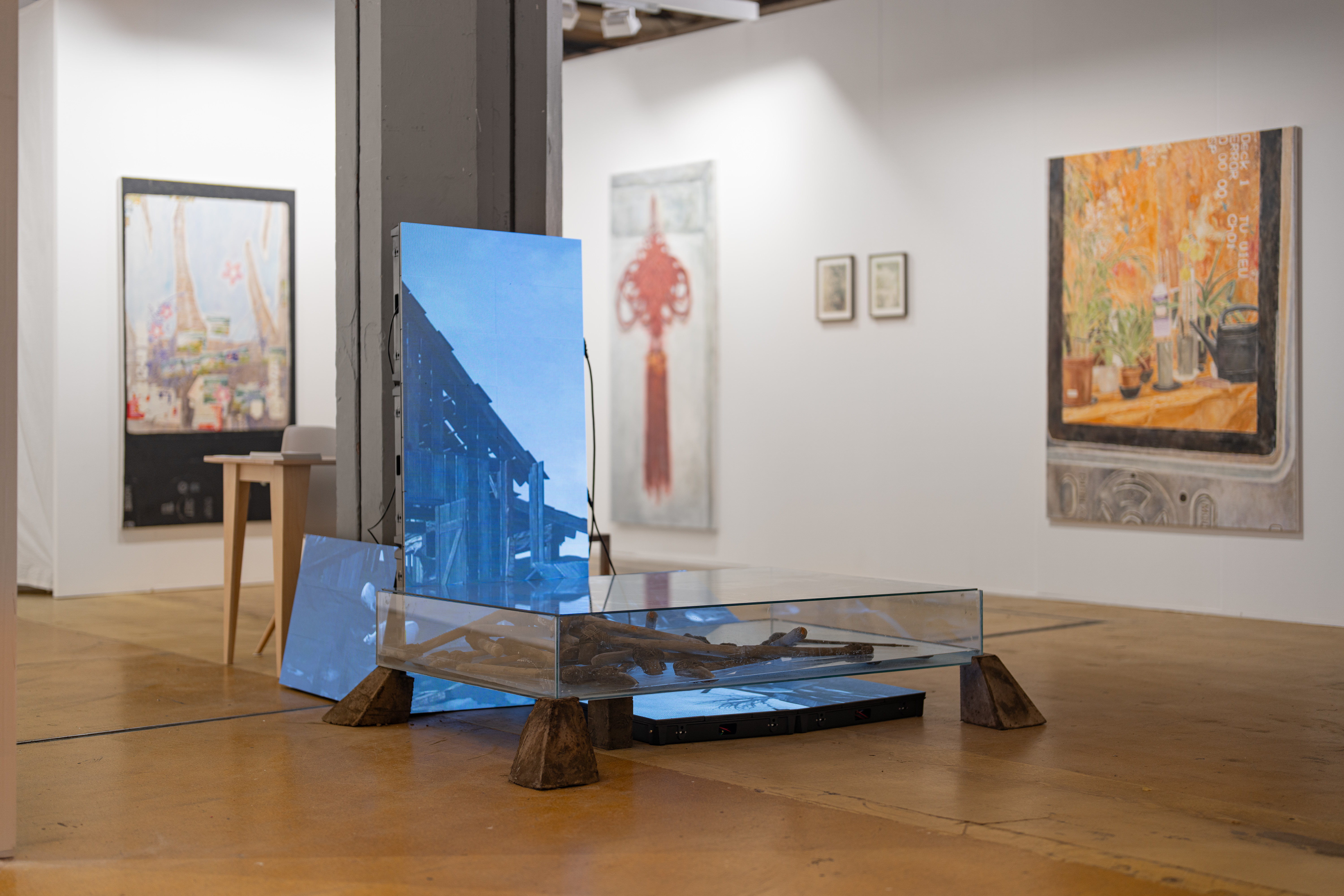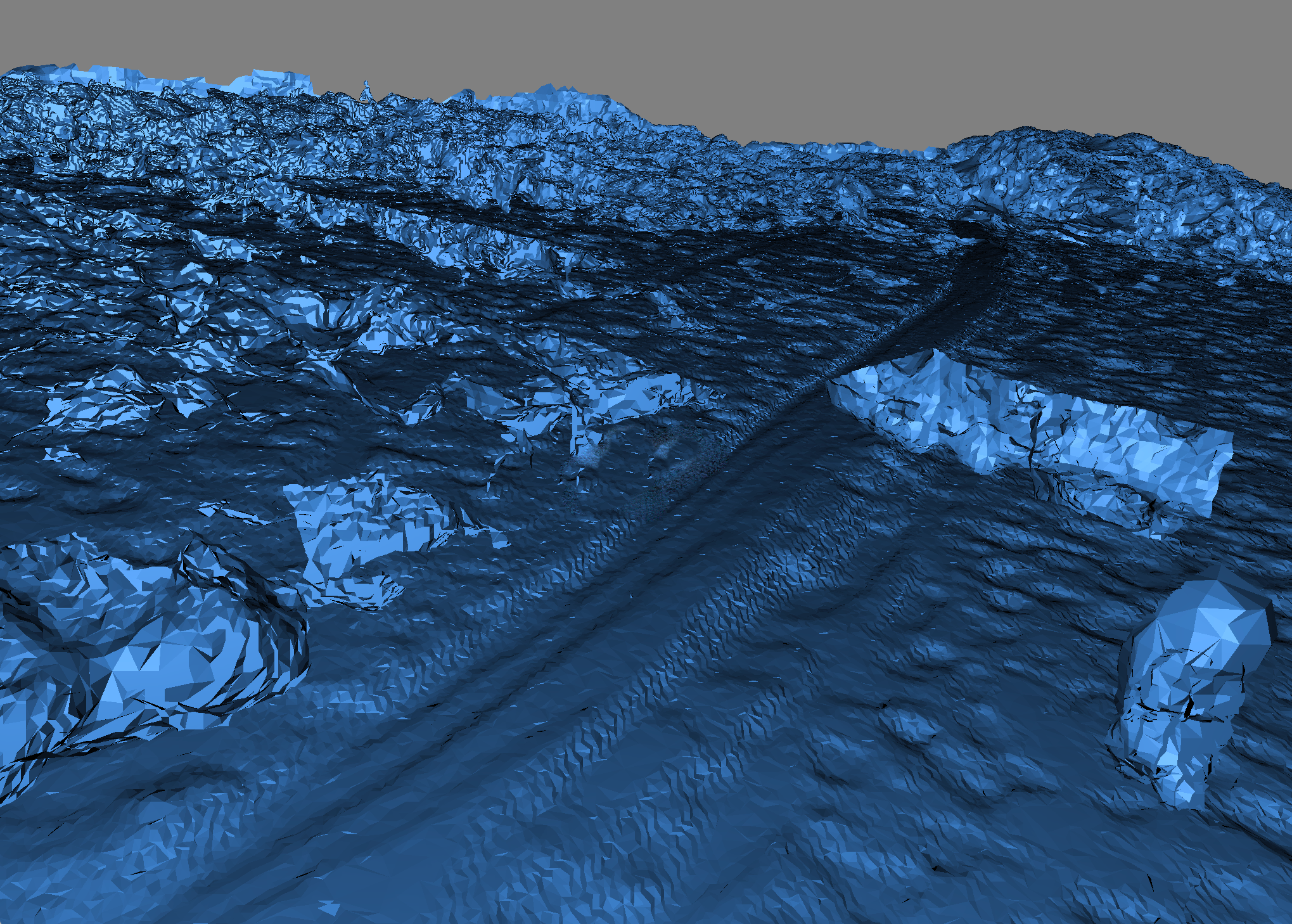 Credit: photo by Jonathan de Waart, courtesy of Josilda da Conceição gallery
Credit: photo by Jonathan de Waart, courtesy of Josilda da Conceição gallery
“Scorched Earth” starts with the story of the Zone Rouge area in France. A place scarred by the violence of World War I. This area, once a battleground, now bears the toxic remnants of warfare, making it uninhabitable for humans.
A digital landscape portrays a wolf hunting lambs. This scene is set in the 3D scan of the actual Verdun battlefield, where craters from century-old explosions still visible. AI controls the animals’ behaviour in real-time.
The second element is a glass container with copies of a Neolithic axe, found in Verdun. These axes, cast in concrete and lead, connect to the material heritage of war. These axes sit in water, slowly leaking chemicals that intensify the AIcontrolled wolf’s aggression.
Lastly, a tall clock, affected by chemical-laden water, grows stalactites on its pendulum. As the pendulum gets heavier, the clock slows down, altering time in the digital landscape. “Scorched Earth” weaves a narrative of violence, memory, and matter, setting conditions for the past, virtual and present to construct a new history.
Filipp: ‘This work is a way of engaging with a place and with history. It is about engaging with the echoes of the past pain rummaging through the landscape and at the same allowing the history to generate something new. The installation combines artefacts from the past to become active participants in a new story that is unfolding in front of the eyes of the viewers.’
Previous work
Groubnov’s recent projects deal with inaccessible places, with a particular focus on soil. Using “traces” in the soil (through sensors or data), he recreates a virtual world as a representation of places that are “lost.
His graduation project for example, revolved around the environment in Belarus where he grew up, but that he cannot return to because of the war. Using soil measurements from the location where he grew up and virtual environments created by a game engine, he reconstructed the memories of his home.
Groubnov works together with the NewMediaCentre of TU Delft for the realization of this work. The NewMedia Centre (NMC) of TU Delft Library is a dynamic multimedia hub for media production, experimentation, research, education, live performance, and learning. The NMC strives to use new media technologies and create media experiences that enable people to get their message across successfully and to help teachers, students, researchers and all employees of TU Delft with their media needs.

Look at all the artefacts and see how they interact real time
About Filipp Groubnov
Filipp Groubnov is an interdisciplinary artist. He was born in Belarus in 1995, where he lived until moving to the Netherlands in 2015 to pursue a career of an artist. Filipp's work is informed by his background in science (having studied in the physics faculty of Belarussian State University), his fascination of the biological systems and their relation to the human symbolism.
“The roots of my practice start in my upbringing in Belarus. The complex interactions between human religious practices and non-human life that I witnessed in the village of my grandparents, the ghostly presence of soviet ideology that left behind numerous material and mental artefacts and the insight into science that I inherited from my parents. The biographical elements from my past appear as anchors for the future works.
My practice is based on creating temporal ‘situations’ which shift and evolve throughout the exhibition. Such situations combine sculptural elements, data-flows and various living and non-living agents. I see my practice as a process of mapping, where the connections and interactions take the main focus. My goal is not in creating fixed knowledge, but rather a space of constant negotiation.
Central to my research is the conviction that the physical realm of the natural sciences and the ethereal realm of communication, cognition and consciousness are part of the same living ‘fabric’. Not as a singular topic in itself, rather I see that conviction as a framework which guides my practice.
Analysing, mapping and exploring different points of interaction between agency and matter. My work becomes a sort of a map where the material landscape is entangled with the ever-changing pool of human psyche and it’s physical manifestations. Through it I investigate the relationship between the nostalgic fictional ‘nature’, speculative beliefs and utopian narratives that deposit as physical sediments in the environment. “
Instagram: @groubnov_filipp
Website: www.groubnov.com
Thanks to
This work is made possible by the Amarte fonds and Gemeente Delft
Metal casting by Dirk de Gieter
3D scan of the battlefield by Rémi de Matos Machado and Joseph Hupy © ONF-SRA–LIDAR 2013
Metal construction by Luis Maly
NewMedia Centre by Yosua Adisapta Pranata MSc and Luuk Goossen – MSc
